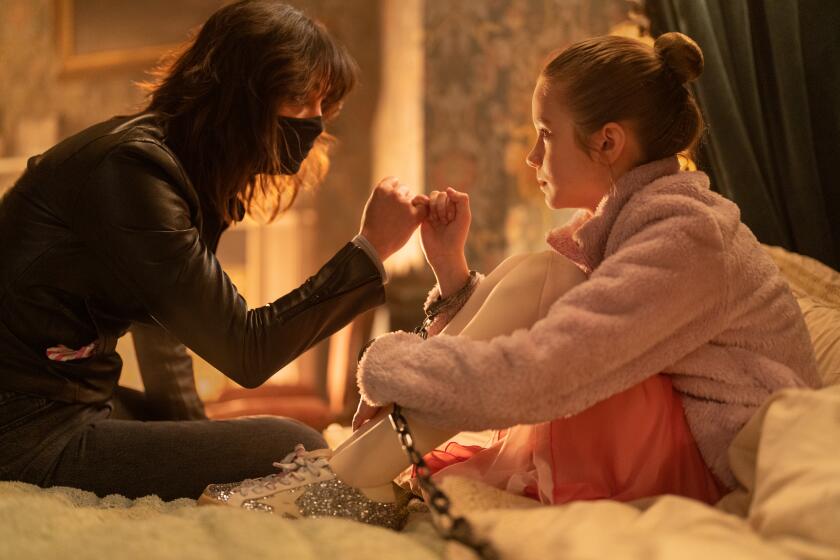Pioneer in blue-screen technology
In the 1950s, special-effects pioneer Petro Vlahos laid the groundwork that made a modern movie genre possible -- the blockbuster.
He did it by vastly improving a composite-image process commonly known as the “blue-screen effect” for the 1959 epic film “Ben-Hur.” And he did it again when he created a related technique that made Dick Van Dyke appear to dance among the penguins in the 1964 movie “Mary Poppins.”
By devising new ways to combine separately shot footage of actors and backgrounds into a single scene, he opened the door to such special-effect spectaculars as “Star Wars” and “Titanic.” Scenes that had been too dangerous, expensive or difficult to film were suddenly possible.
Every film since that has employed a form of the technique owes a debt to Vlahos, industry experts said.
Vlahos, who received multiple Oscars for technological achievements, died Feb. 10, his family announced. He was 96. No other details were released.
“It’s hard to emphasize the import of his inventions,” Bill Taylor, a visual effects supervisor, said at the Scientific and Technical awards ceremony held by the Academy of Motion Picture Arts and Sciences the night before Vlahos died. “He created the whole of composite photography as we know it.”
While serving as an assistant manager at the academy’s Motion Picture Research Center, Vlahos spent six months thinking up his patented “color-difference system traveling matte scheme” for “Ben-Hur” and its spectacular chariot race, he later said.
He advanced the blue-screen effect in a major way by minimizing a strange side effect -- halos that appeared around actors and objects when footage shot against a blank screen was fused with action shots. The process would eventually include green screens.
Vlahos also held a patent for a similar technique called sodium vapor composite photography, which unknown to him had been developed in Britain in the 1950s. His version yielded results that were considered superior to the blue-screen process.
To test his idea, Vlahos borrowed sodium-powered street lights from the Department of Water and Power. He outfitted a camera with a prism that split the image into two elements, part of a complex process that resulted in a more realistic blending of animation and live action.
The innovation was used in “Mary Poppins” and many other Disney films, including “The Love Bug” (1969) and “Bedknobs and Broomsticks” (1971). Alfred Hitchcock borrowed the technology for his 1963 film “The Birds.”
As an inventor of movie-related gadgets, Vlahos held more than 35 patents. They included low-cost screen-brightness meters, camera-crane motor controls and a method for detecting distortion in soundtracks.
“Petro kept refining his ideas. That’s what distinguishes him in a lot of ways,” Harrison Ellenshaw, a visual-effects artist who worked on the “Star Wars” films, told The Times.
“It’s one thing to invent the steam engine; it’s another to keep bringing it forward, to keep making those steps and those advancements,” Ellenshaw said. “And that was his genius.”
Born Aug. 20, 1916, in Raton, N.M., Vlahos moved to San Pedro with his family when he was 8.
After earning a bachelor’s degree in 1941 from UC Berkeley, he became a designer at Douglas Aircraft during World War II.
While working as a radar engineer at Bell Labs, he met an MGM sound director who connected him with the Motion Picture Research Council. He worked at the council until it was dissolved in 1960, then managed a military contractor’s physical sciences department.
When the academy opened its Motion Picture Research Center in 1968, he returned to film research as its chief scientist.
He founded Chatsworth-based Ultimatte Corp. in 1976 to research and develop composite technology. Two years later, he received an Emmy Award for his work.
In 1965, Vlahos and his collaborators were awarded an Oscar for the composite processes they developed. Thirty years later, he shared another Academy Award with his son, Paul, for creating Ultimatte’s blue-screen process.
In addition to his son, Vlahos is survived by his wife, Virginia; daughter Jennie Vlahos Gadwa; stepchildren Sandra Bentley King and James Bentley; grandchildren and great-grandchildren.
--
More to Read
Only good movies
Get the Indie Focus newsletter, Mark Olsen's weekly guide to the world of cinema.
You may occasionally receive promotional content from the Los Angeles Times.







